Analyzing the Scale and Effects of the Pacific Garbage Patch
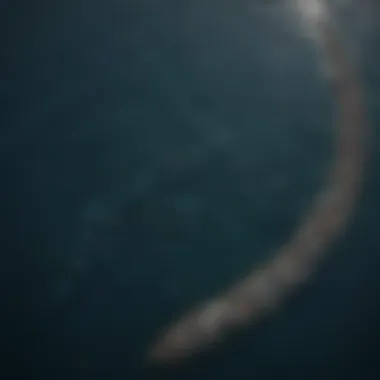
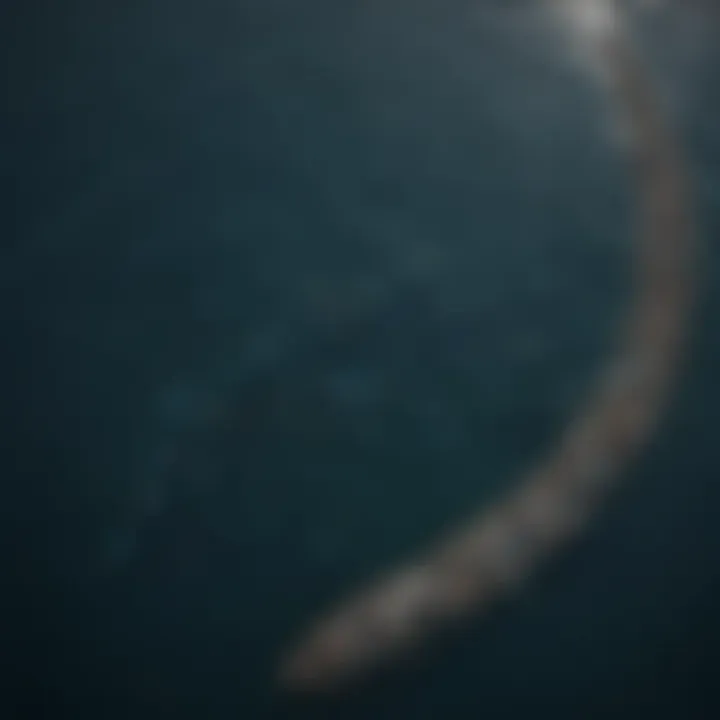
Intro
The immense scale of the Pacific Garbage Patch, often viewed as a graphic representation of our environmental negligence, raises critical questions about marine pollution. This issue isn’t just a random blot on the ocean’s surface; it symbolizes complex interplays between human activity and natural systems. The vastness of this phenomenon is often misunderstood or underestimated, making a thorough assessment necessary for understanding its impact on marine ecology and human health.
The notion of size can be tricky when discussing the Pacific Garbage Patch. It isn't a singular entity but rather a colossal collection of debris, primarily plastic, that is dispersed across a significant area of the North Pacific Ocean. Monitoring its dimensions requires advanced methodologies and a touch of scientific rigor that will unearth not just its current state but also inform future remediation efforts.
It’s essential to recognize that the Garbage Patch isn't a static figure; it changes continuously due to currents, wind patterns, and human actions. Understanding this dynamic nature necessitates a comprehensive approach that draws insights from multiple scientific disciplines—oceanography, environmental science, sociology, and even economics.
Each piece of plastic, each margin of size, carries with it a story of human consumption and wastefulness. It's crucial for students, researchers, educators, and professionals to grasp the gravity of this issue and realize the larger implications it poses for our shared responsibility towards the planet.
Prelude
The issue of marine pollution isn’t just an environmental concern; it’s a pressing global challenge that impacts human health, wildlife, and economic stability. In this article, we aim to dig deeper into a critical aspect of this problem—the Pacific Garbage Patch. Understanding the size of this patch is fundamental. It provides insight into the extent of plastic pollution, helping inform policy decisions and public awareness campaigns aimed at addressing this crisis.
As we embark on this exploration, it’s essential to highlight several key elements: the geographic scope of the patch, its physical characteristics, and the methodologies used to measure its vastness. Each of these components sheds light on why the Pacific Garbage Patch demands immediate attention. Not only does it catalyze a discussion about environmental ethics, but it also underscores the need for collective action and innovative solutions.
This section sets the stage for a detailed analysis that follows, addressing significant questions about the size of the patch and its implications for marine ecosystems and human livelihoods. By grasping the scale of this marine debris issue, stakeholders can better strategize for effective cleanup efforts and foster initiatives that advocate for sustainable practices across various sectors.
"If we don’t measure it, we can’t manage it—this couldn’t be truer than in the case of marine pollution."
"If we don’t measure it, we can’t manage it—this couldn’t be truer than in the case of marine pollution."
In the sections that follow, we will unravel the complexities behind the Pacific Garbage Patch, offering a robust framework for understanding its sheer size and the urgency with which we must tackle this environmental plight.
Defining the Pacific Garbage Patch
Understanding the Pacific Garbage Patch means grappling with more than just a heap of trash floating in the ocean. It is essential to define it properly to grasp its impact on marine life, environmental health, and even human wellbeing. By investigating what the Pacific Garbage Patch actually encompasses, we can uncover the myriad factors contributing to the problem. This section lays the groundwork for appreciating why clarity in definition is critical. Without precise metrics and a clear scope, discussions around remediation efforts can lack the necessary context and urgency.
Geographic Scope of the Patch
The Pacific Garbage Patch isn't a single, solid mass of debris as many might think; rather, it stretches across a vast area of ocean, which raises complex questions about measurement and visibility. Primarily located between Hawaii and California, this area isn't defined by rigid geographical boundaries.
The patch represents an accumulation zone, driven by ocean currents that trap pollutants in the North Pacific Gyre, a massive circular current that influences a vast region.
The patch represents an accumulation zone, driven by ocean currents that trap pollutants in the North Pacific Gyre, a massive circular current that influences a vast region.
This characteristic can lead to underestimations or misinterpretations of its actual size. Previous studies have indicated it occupies roughly 1.6 million square kilometers—larger than the size of Alaska. However, this figure varies based on specific definitions and methodologies employed.
Some researchers argue that it extends beyond the commonly acknowledged borders, particularly if we consider microplastic distribution. Key factors to consider include:
- Drift patterns: The movement of ocean currents plays a pivotal role in shaping the geographic contours of the patch.
- Seasonal variations: Different times of the year can also affect the concentration of debris due to environmental conditions.
- Human activity: Coastal cities contribute to the patch not only through direct waste but also indirectly through river systems transporting litter into the sea.
By mapping the geographical scope effectively, researchers can better illustrate the urgent need for intervention, emphasizing that the challenge is not confined to a singular location. Understanding this geographical variability can also aid in the development of tools to track movement and changes in debris concentration.
Physical Characteristics
Defining the physical aspects of the Pacific Garbage Patch dives deeper into what actually constitutes this environmental phenomenon. The patch comprises not just large, visible objects, but an alarming amount of tiny particles collecting in the water. This physical makeup can be categorized primarily into two groups:
- Macroplastics: These are the larger items easily spotted, such as discarded fishing gear, plastic bottles, and even larger fragments broken down from initially bigger products.
- Microplastics: More insidiously, microplastics—tiny plastic particles less than five millimeters in size—have infiltrated the ocean, posing serious risks to marine life.
The term "plastic soup" often comes to mind, reflecting the chaotic amalgamation of different materials. These plastics degrade over time into smaller pieces due to environmental factors such as UV light and wave action, but they never truly disappear. Instead, they become part of a toxic cocktail that threatens marine biodiversity and food webs.
Recent studies have shown that, alarmingly, a single square kilometer of the patch can contain anywhere from 2 to 10 million pieces of plastic. This density of debris complicates cleanup efforts, as these particles can be almost invisible to the naked eye and increasingly prevalent in the food chain. The physical characteristics of the patch are crucial data points that prompt discussions about the technological measures required for effective cleanup and how to mitigate further pollution.
In summary, elucidating the geographic scope and physical characteristics frames the conversation around what the Pacific Garbage Patch is and why it matters. This critical understanding lays a firm foundation for tailored approaches to address the pressing issues at hand.
Measurement Methodologies
Understanding the methodologies behind measuring the Pacific Garbage Patch is crucial, considering the enormity and complexity of this environmental issue. Each approach carries its unique advantages and limitations, making it necessary to adopt a multi-faceted strategy for accurate assessment. By examining diverse measurement methodologies, we can appreciate their contributions to comprehensively mapping the scope and severity of this phenomenon.
Satellite Observations
Satellite technology has revolutionized our capability to monitor environmental issues from a macro perspective. It allows for a wide-reaching surveillance of the Pacific Garbage Patch, capturing data that would be infeasible or impossible to gather solely through conventional methods.
Satellites equipped with high-resolution cameras can identify surface debris and its distribution at exceptional altitudes, providing an expansive view of the patch. They employ various spectral bands to differentiate types of materials, such as plastics versus natural debris, which is critical in understanding the composition of garbage.
Significantly, satellite data allows for the tracking of physical changes over time, revealing how the patch expands or contracts and how currents impact its size. This real-time data aids in visualizing trends and developing predictive models, which are essential for future conservation efforts. However, challenges remain, such as the difficulty in pinpointing small debris and the limitations imposed by weather conditions affecting visibility.
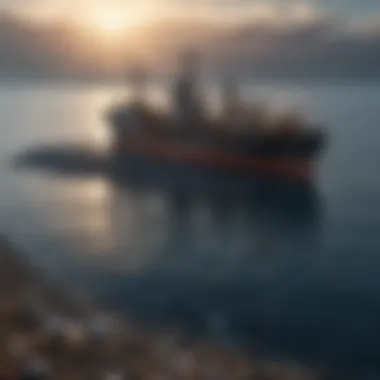
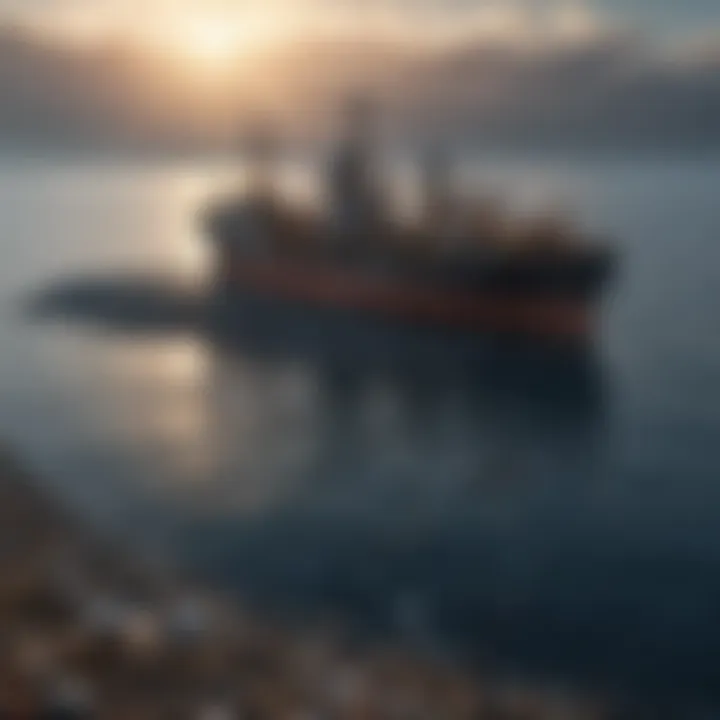
In-situ Sampling Techniques
In-situ sampling entails direct collection of samples from the ocean, offering an on-the-ground glimpse into the patch's reality. This technique includes deploying specialized nets to capture plastic debris, which allows researchers to obtain quantitative data about particle size, type, and concentration.
By gathering samples from various depths and locations within the patch, scientists enhance their understanding of how debris is distributed spatially and vertically. In-situ techniques provide a more detailed view of the ecological impact of the garbage, as researchers can analyze how these materials interact with marine life firsthand.
Despite the advantages, in-situ sampling is labor-intensive and often limited by accessibility. Weather and ocean conditions can affect the ability to collect valid samples, meaning that results may not always be representative of the larger patch.
Identifying Data Discrepancies
As valuable as these measurement methodologies are, discrepancies in data can pose significant challenges in establishing a clear understanding of the Pacific Garbage Patch. This inconsistency often arises from differences in methodology, spatial coverage, and even the interpretation of data collected. Some studies may report higher estimates of the patch's size due to specific sampling methods that capture a broader range of debris, while others might yield conservative figures by focusing only on certain locations.
Moreover, the variability in how measurements are taken—whether through satellite observation at different times or varied in-situ sampling techniques—can lead to contrasting conclusions about the patch's magnitude. Addressing these discrepancies is essential for developing strategic and effective remediation efforts. Consequently, a unified methodology could help establish standardized metrics and enhance the credibility and comparability of research findings.
"A contradiction in data can lead to mixed messages about urgency in tackling ocean pollution, making it vital to address inconsistencies."
"A contradiction in data can lead to mixed messages about urgency in tackling ocean pollution, making it vital to address inconsistencies."
In summary, a blend of methodologies provides a more comprehensive picture—merging satellite observations with in-situ sampling data reveals the broad and intricate nature of the Pacific Garbage Patch. The challenge, however, remains to reconcile discrepancies in findings, ultimately steering clear towards informed interventions and awareness initiatives.
Quantifying Size and Volume
Understanding the size and volume of the Pacific Garbage Patch is essential for grasping the full scope of marine pollution. Without precise measurements, it’s nearly impossible to develop effective mitigation strategies or even to convey the seriousness of the situation. Estimates of size and volume thus serve multiple roles: they inform public discourse, guide research priorities, and help shape policy decisions.
Current Estimates
Currently, estimates of the patch’s size can range widely. Some studies suggest the area may cover over 1.6 million square kilometers, while other interpretations of the data might indicate even larger figures. This variability arises from differences in methodology, in-situ sampling, and satellite imagery analysis. The patch is not a solid mass of trash; rather, it consists of a plethora of small plastic particles drifting throughout the ocean.
- For instance, the Ocean Cleanup Project, which embarked on a mission to clean the patch, estimates that the patch contains approximately 1.8 trillion pieces of plastic.
- On the contrary, a study published in the journal Nature estimates that the mass of plastic is closer to 80,000 metric tons.
This disparity highlights a significant gap in our understanding and emphasizes the need for more robust data collection methods. The efforts to quantify this pollution not only underscore the challenge but also open avenues for scientific inquiry and innovation in remediation techniques.
"Without reliable estimates, our collective efforts to combat this issue may well be akin to attempting to catch smoke with bare hands."
"Without reliable estimates, our collective efforts to combat this issue may well be akin to attempting to catch smoke with bare hands."
Saucing together current data helps to shape a clearer picture of these ongoing dynamics and provides a foundation for addressing the issue holistically.
Comparative Analysis Over Time
A historical viewpoint on the size and volume of the Pacific Garbage Patch adds further layers to the discourse on marine pollution. Comparing current estimates with those from the previous decades reveals not just an environmental challenge but also the evolution of our understanding of marine debris.
- When the term "garbage patch" first hit public consciousness in the early 2000s, it was based on less extensive data, leading to misrepresentations and misunderstandings about its actual impact. At that time, the estimates hovered below one million square kilometers.
- Fast forward to today, and the scientific community has refined its methodologies, leading to larger estimates. This increase can largely be attributed to rising plastic production and consumption across the globe, alongside better technological advances in monitoring.
In examining these evolving figures, it’s crucial to consider external factors:
- Plastic Production Rates – Research shows that global plastic production has increased exponentially. In the 1950s, it was approximately 2 million metric tons; now, it exceeds 400 million metric tons annually.
- Marine Traffic and Urbanization – As coastal cities become busier and industrial activities escalate, the chances for maritime pollution significantly increase.
The correlation between these factors and the changing estimates emphasizes an undeniable reality: our oceans are in peril, and the consequences of human activities must spur immediate action.
Monitoring tools and the willingness to adapt methodologies will be key for future assessments, making the dialogue surrounding the ever-looming Pacific Garbage Patch not just an academic exercise, but a collective call for understanding and responsible action.
Impact on Marine Ecosystems
The presence of the Pacific Garbage Patch casts a long shadow on marine ecosystems. As the accumulated plastic and debris disrupt habitats and threaten marine biodiversity, understanding these impacts is crucial for stakeholders ranging from scientists to policymakers. The Pacific Garbage Patch serves as a stark reminder of human negligence and its far-reaching consequences. In this section, we will explore how marine life is affected by this phenomenon, focusing on two substantial areas: biodiversity and habitat disruption, and the implications of microplastics within food chains.
Biodiversity and Habitat Disruption
Biodiversity in marine environments is an intricate web, with each species playing a unique role. When pollution enters these ecosystems, the equilibrium gets thrown out of balance. The Pacific Garbage Patch hosts a myriad of abrasive materials—plastic, derelict fishing gear, and organic waste—that can physically harm marine species. For instance, entanglement in fishing nets or ingestion of microplastics can spell doom for various marine creatures, from seabirds to marine mammals.
Additionally, the introduction of non-native species is another issue. As debris floats in ocean currents, it can transport organisms to new locales. This can lead to competition with indigenous species for resources, ultimately resulting in species decline. Furthermore, the habitats of coral reefs, which serve as crucial breeding grounds, are jeopardized by the shading effect of floating debris. Studies have shown that these areas suffer from reduced light penetration, hindering the growth of essential algae, which in turn affects the entire food chain.
Key impacts of biodiversity and habitat disruption include:
- Decline in fish populations due to loss of breeding grounds
- Increased vulnerability of species to diseases and predation
- Altered predator-prey relationships, creating a ripple effect through ecosystems
"A healthy marine ecosystem is vital for the planet's overall health, and the Pacific Garbage Patch threatens this balance in profound ways."
"A healthy marine ecosystem is vital for the planet's overall health, and the Pacific Garbage Patch threatens this balance in profound ways."
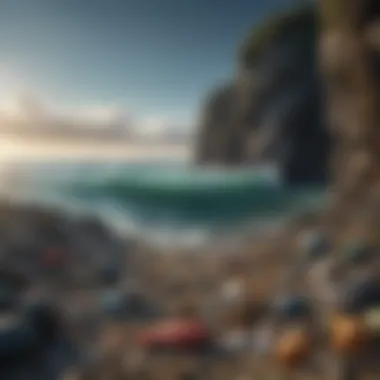
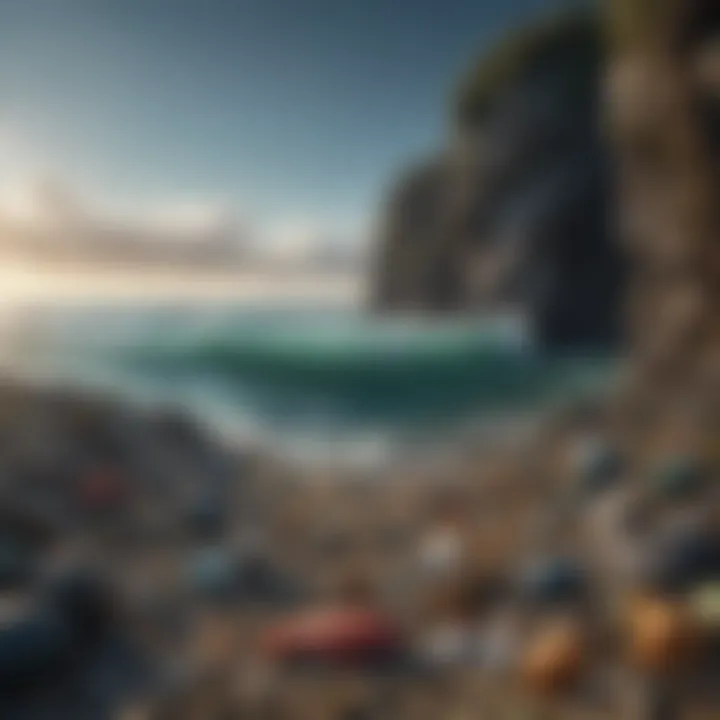
Microplastics and Food Chains
Microplastics pose a lesser-known yet equally menacing threat to marine ecosystems. These tiny plastic particles, formed as larger items break down, are now ubiquitous in the ocean environment. Once ingested, they can move up the food chain, impacting organisms at every level—from plankton to apex predators. The implications of this chain reaction are worrisome. Filter feeders, such as mollusks and some fish species, consume microplastics alongside their food, leading to biological magnification. This process can cause toxic effects, ranging from reproductive issues to hindered growth rates, threatening species survival.
Moreover, as predators consume prey that contain microplastics, they unknowingly accumulate higher concentrations of these particles within their own bodies. This accumulation can culminate in various health issues, manifesting in reproductive failure or diminished resilience against disease.
In Summary
The impact of the Pacific Garbage Patch on marine ecosystems is staggering. It disrupts biodiversity and damages habitats while introducing toxic microplastics into the food chain. Protecting marine environments necessitates immediate action and concerted efforts to address the ongoing pollution. Ignoring these challenges could lead to irreversible consequences for countless marine species and, ultimately, human societies that rely on these ecosystems for sustainability.
Socio-Economic Repercussions
Understanding the socio-economic repercussions of the Pacific Garbage Patch is vital as it demonstrates how environmental issues seep into the economic and social fabric of coastal communities. The presence of this debris not only affects marine life but also casts a shadow over local economies dependent on fishing and tourism. This section will dissect how these elements converge, presenting a holistic view of the challenges ahead.
Impact on Fisheries
Fisheries hold substantial value for communities bordering the Pacific Ocean. They provide food, income, and will some cases, a way of life. However, the Pacific Garbage Patch casts a long, dark shadow over these industries. Fish and other marine organisms often mistake plastic for food, leading to a significant decline in fish populations and ultimately threatening sustainability.
The economic impact is extensive. When fish stocks dwindle, fishermen face reduced catch volumes and lower revenues. This economic fallout doesn’t just hammer direct fishing jobs. It ripples across the entire supply chain, affecting processing plants, distribution networks, and local vendors.
"The issue isn’t just about fish disappearing; it’s about livelihoods erasing."
"The issue isn’t just about fish disappearing; it’s about livelihoods erasing."
Moreover, contamination from microplastics can infiltrate the food supply, raising concerns among consumers and thus impacting market demand. A notable point to keep in mind is that in the U.S. alone, the fishing industry is worth more than 200 billion annually. With much at stake, the direct relationship between marine pollution and economic viability cannot be overstated.
Tourism and Coastal Communities
Tourism serves as the lifeblood for many coastal regions. Picture a beautiful beach: sun-kissed sands, crystal-clear waters, and vibrant marine life. This is the imagery that attracts millions. However, the reality painted by the Pacific Garbage Patch has resulted in a tarnished reputation for picturesque destinations.
As word spreads about marine pollution, potential tourists reconsider their vacation plans. Consequently, hotels, restaurants, and local attractions suffer. It’s enough to make any small business owner fret: 65% of tourists consider environmental impact when choosing a destination.
Communities face additional challenges:
- Increased cleanup costs.
- Pressures on local governance to manage waste.
- A decline in overall quality of life as beaches become less inviting.
Profiles of travelers slowly shift as eco-conscious individuals seek destinations that prioritize sustainability. This shift can, in a way, create both challenges and opportunities. Coastal communities must grapple with remodeling their tourism strategies to accommodate these expectations if they hope to thrive long-term.
In summary, the socio-economic repercussions of the Pacific Garbage Patch reveal a complex tapestry woven with environmental, economic, and social threads. As these impacts become clearer, communities must adapt and find innovative solutions to tackle them effectively.
Current Remediation Efforts
The Pacific Garbage Patch is not just a distant, abstract issue; it's a pressing environmental challenge that influences both marine life and human society. Understanding the current remediation efforts is essential for grasping how scientists, activists, and policymakers are working to tackle this floating crisis. These endeavors can lead to significant benefits, including the protection of marine ecosystems, restoration of natural beauty, and preservation of human livelihoods.
Technological Innovations
At the forefront of remediation efforts are various technological innovations aimed at cleaning up the patch and preventing further pollution. Key technologies include:
- Ocean Cleanup Systems: Organizations like The Ocean Cleanup have designed specialized systems, such as floating barriers, that capture debris while allowing marine life to pass underneath. The barriers utilize the natural ocean currents, effectively collecting plastic without much energy input.
- Drone Monitoring: Technology isn't just for cleanup; monitoring plays a vital role too. Drones equipped with cameras and sensors provide real-time data on the size and distribution of debris. This information helps gauge the efficiency of cleanup operations and identifies areas needing attention.
- Plastic-to-Fuel Converters: Some innovative approaches involve converting collected plastic waste into fuel. This not only reduces the volume of waste but creates a new energy source. Such systems could potentially help in maintaining the economic viability of cleanup operations.
A case study worth noting is the Interceptor, which is a solar-powered vessel designed to extract plastic from rivers before it reaches the oceans. This proactive approach can significantly reduce the input of plastics into the marine environment, making it a crucial aspect of an integrated remediation strategy.
Global Initiatives and Collaborations
Addressing the Pacific Garbage Patch requires collective action, and various global initiatives exemplify this collaborative spirit. Several ongoing efforts include:
- United Nations’ Clean Seas Campaign: This initiative encourages countries to commit to reducing marine litter through legislative action and public awareness campaigns. Participating nations share best practices and engage in cooperative cleanup projects, fostering an international network for effective action.
- #BeatPlasticPollution: A global call to action that encourages individuals and organizations to engage in reducing single-use plastics. This campaign leverages the power of social media to mobilize public support for reducing plastic pollution.
"The cleanup of the Pacific Garbage Patch is about more than just removing debris; it’s about reshaping the way we engage with our oceans and understanding our role in their health."
"The cleanup of the Pacific Garbage Patch is about more than just removing debris; it’s about reshaping the way we engage with our oceans and understanding our role in their health."
- Scientific Collaborations: Researchers from various fields, including marine biology, environmental science, and engineering, are teaming up to better understand the patch and develop innovative solutions. This interdisciplinary approach is vital for forging effective remediation strategies.
In summary, the various technological innovations and global collaborations represent vital steps in the ongoing fight against marine pollution. More than just efforts to scoop debris from the ocean, these initiatives embody a broader commitment to sustainability and environmental stewardship, ensuring that we at least start addressing our wasteful habits before they spiral too far out of control.
Legislative Framework
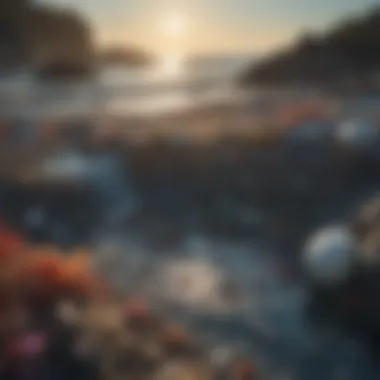

The legislative framework surrounding the Pacific Garbage Patch is vital for coherent and effective action against marine pollution. Without appropriate laws and regulations, attempts to address the issues posed by this massive concentration of debris are unlikely to yield positive outcomes. This section will discuss both international treaties and national policies that aim to mitigate plastic pollution and maintain the health of marine ecosystems.
International Treaties and Agreements
On the global stage, several treaties and agreements focus on marine conservation and pollution control. One of the most significant is the Convention on the Prevention of Marine Pollution by Dumping of Wastes and Other Matter, commonly known as the London Convention. This treaty is instrumental in regulating waste disposal at sea, aiming to prevent pollution from entering the marine environment. Countries that are party to this convention are required to assess the impact of their waste disposal practices and minimize harmful pollution.
Another notable agreement is the United Nations Convention on the Law of the Sea (UNCLOS). UNCLOS sets out the legal framework within which all activities in the oceans and seas must be conducted, including rules about the protection and preservation of the marine environment. In particular, it emphasizes the responsibility of states to prevent and control pollution from ships and land-based sources.
"Effective international treaties and agreements create a stronger network in the fight against marine pollution, yet their success significantly relies on commitment from member countries."
"Effective international treaties and agreements create a stronger network in the fight against marine pollution, yet their success significantly relies on commitment from member countries."
While these international frameworks outline critical goals, their impact is heavily dependent on individual nations’ commitment to enforce regulations and promote practices that align with treaty objectives. Thus, international cooperation becomes a cornerstone not just for crafting these laws but also for their implementation, monitoring, and enforcement across borders.
National Policies and Their Efficacy
At the national level, countries can introduce policies that build upon international agreements. Policies that prioritize reducing plastic consumption, improving waste management systems, and promoting public awareness campaigns can create significant changes. For instance, some nations have adopted bans on single-use plastics or implemented deposit return systems for bottles, encouraging recycling and reducing litter.
The efficacy of such policies can greatly vary. A well-defined policy can have a notable impact, evidenced in regions such as California, where stringent regulations on plastic usage and waste have led to a measurable decrease in coastal debris. Conversely, in other locations, the lack of enforcement mechanisms or public compliance can render ambitious policies ineffective.
To maximize impact, it would be beneficial for national policies to align more closely with international treaties, ensuring consistency and commitment towards a common goal of reducing marine pollution.
Combining the efforts of international treaties and localized policies highlights the importance of a detailed legislative framework. This synergy not only tackles the immediate challenges posed by the Pacific Garbage Patch but also lays the groundwork for sustainable practices moving forward, ensuring that our oceans receive the protection they desperately require.
Public Awareness and Education
The significance of public awareness and education regarding the Pacific Garbage Patch cannot be overstated. It plays a critical role in shaping perceptions, behaviors, and ultimately, solutions to marine pollution. Raising public knowledge provides individuals with the tools they need to make informed decisions regarding their consumption and disposal practices. As the old saying goes, "You can’t manage what you don’t measure." In the context of marine pollution, awareness is prerequisite to effective action.
A better understanding of the factors contributing to the Garbage Patch allows communities to acknowledge their part in the environmental crisis. Moreover, education fosters a sense of stewardship over our oceans, encouraging collective responsibility for their health and sustainability. When individuals recognize the impact of their actions, such as littering or overusing plastics, they become more likely to adopt environmentally friendly practices.
Role of Media and Social Platforms
In our modern world, the media and social platforms are indispensable tools for spreading awareness about environmental issues. Through social media campaigns, the concept of the Pacific Garbage Patch has reached wider audiences, informing them about its existence and impacts.
Platforms like Facebook and Instagram have become avenues for grassroots movements advocating for cleaner oceans. Information shared through these channels can stimulate dialogue and inspire action. Engaging infographics, images of marine wildlife affected by pollution, and even firsthand accounts from those participating in cleanup efforts work powerfully to raise awareness.
Moreover, reputable news outlets play a vital role by reporting on the ongoing challenges posed by the Pacific Garbage Patch. These stories can reach people who may not be engaged with environmental activism but nonetheless need to be made aware. Public figures and celebrities joining the conversation can provide additional traction, encouraging wider participation.
"The journey of a thousand miles begins with one step." — Laozi. Every post shared about marine health is a step forward in the awareness journey.
"The journey of a thousand miles begins with one step." — Laozi. Every post shared about marine health is a step forward in the awareness journey.
Community Engagement Initiatives
Community engagement initiatives are crucial in fostering localized action against marine pollution. These programs help in bridging knowledge gaps and facilitate direct involvement of citizens in clean-up activities or educational workshops. Local organizations often conduct workshops to teach residents about the detrimental impacts of plastic waste. These sessions can be eye-openers, offering insight into how everyday choices lead to larger environmental issues.
Such initiatives also encourage people to form connections with their local environment, enhancing their commitment to protecting it. Volunteer events, such as beach cleanups, create both awareness and camaraderie. Participants often leave these events with not just a sense of accomplishment, but also with valuable information that they can share within their own social circles.
Additionally, schools can introduce educational programs focusing on marine pollution, harnessing the curiosity of younger generations to instill a long-lasting ethic of care for the environment. A vibrant community united in action can catalyze monumental change in combatting adversity like the Pacific Garbage Patch.
As we examine the vastness of the issue, it becomes clear that every effort, big or small, contributes to a collective goal of cleaner oceans and healthier ecosystems.
Ending
As we wrap up this exploration into the Pacific Garbage Patch, it becomes clear that assessing its size is not just a matter of curiosity; it serves as a critical focal point in our understanding of marine pollution. Accurate measurements guide the strategies for remediation and inform public policy. They shine a light on the urgency of national and international efforts aimed at combating marine debris. This topic serves several essential elements:
- Awareness: Understanding the size of the Garbage Patch raises awareness about the broader implications of plastic waste in the oceans, reminding us that this issue extends beyond aesthetics.
- Policy Making: Data-driven insights are invaluable for lawmakers and environmental agencies. Well-measured estimates help prioritize funding and resources to tackle the most impacted areas effectively.
- Scientific Research: The size and dynamics of the Garbage Patch fuel ongoing research in marine ecology and environmental science, leading to innovative solutions and methods to monitor ocean health.
In essence, the conclusion of this article solidifies the idea that continuous dialogue and research around the Pacific Garbage Patch are paramount. The impacts reach far into our ecosystems, economies, and even our everyday lives.
Future Perspectives
Looking ahead, it’s evident that our tactics must evolve as we learn more about the complexities of marine pollution. Researchers are constantly developing new technologies that aid in both measuring and cleaning up the debris. For instance, advances in satellite imaging can help monitor changes in the size of the garbage patch over time, potentially revealing seasonal alterations linked to climate patterns and tidal behaviors.
Additionally, the growing awareness of microplastics might lead to new materials that could replace conventional plastics. The ongoing dialogue around biodegradable and sustainable alternatives offers some potential hope. Moreover, increased collaboration between nations can strengthen regulatory frameworks and enhance enforcement. The future looks different, but the path forward demands sustained effort and innovation.
Call to Action
The responsibility to address the issue of the Pacific Garbage Patch doesn't solely lie with environmental organizations or governments. As individuals, we have a part to play in the larger picture. Here’s how one might take action:
- Reduce Single-Use Plastics: Evaluate personal consumption habits; simply cutting down on plastic usage can create a ripple effect.
- Support Local Cleanup Initiatives: Engage with community programs focused on beach cleanups. These seem like small efforts, but collectively they really matter.
- Educate Others: Having conversations about the significance of marine conservation can inspire action within one’s circle of friends and family.
- Advocate for Policy Changes: Engage with local representatives about the need for stricter regulations on waste management and pollution controls.
"Every small effort counts when it comes to protecting our planet. The Pacific Garbage Patch is a reflection of our actions; to change that narrative, we must start locally, think globally."
"Every small effort counts when it comes to protecting our planet. The Pacific Garbage Patch is a reflection of our actions; to change that narrative, we must start locally, think globally."



